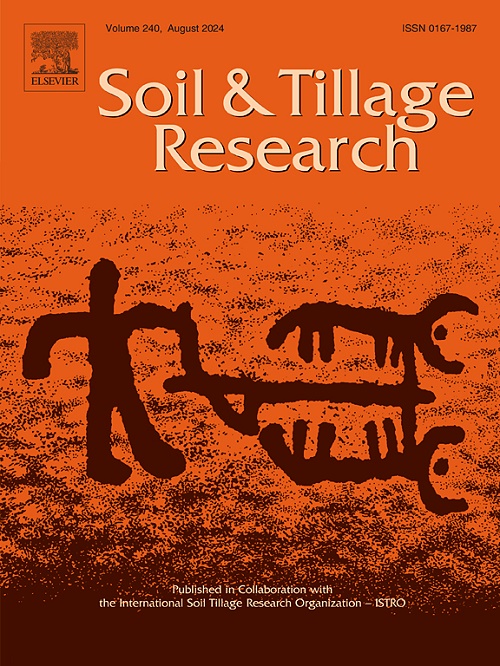溅蚀下土壤团聚体破碎形成对土壤有机碳矿化的驱动机制
IF 6.1
1区 农林科学
Q1 SOIL SCIENCE
引用次数: 0
摘要
溅蚀引发水分侵蚀,并通过破碎土壤颗粒和影响土壤有机碳矿化显著影响土壤有机碳动态。然而,土壤团聚体周转与有机碳矿化和二氧化碳排放之间的联系机制尚不清楚。为了研究侵蚀条件下土壤团聚体和有机碳的命运,在降雨强度为60、90和120 mm/h的条件下进行了雨滴溅落侵蚀试验。四种类型的稀土氧化物用于标记不同尺寸的土壤团聚体:大(2-5 mm),中(1-2 mm),小(0.25 - 1 mm)和微(<0.25 mm),然后进行56天的土壤培养。结果表明,降雨强度对土壤团聚体的破碎和形成有显著影响。土壤团聚体的平均累积破碎率随降雨强度增大而增大:120 mm/h(12.02 %)>; 90 mm/h(9.49 %)>; 60 mm/h(8.19 %)。土壤团聚体的平均累积形成速率为60 mm/h(12.25 %)>; 90 mm/h(10.90 %)>; 120 mm/h(8.32 %)。土壤团聚体破碎的主要模式是由中到小,第0天破碎率最高,随降雨强度的增大而增大:120 mm/h(58.49 %)>; 90 mm/h(48.07 %)>; 60 mm/h(43.61 %)。同时,随着降雨强度的增加,有机碳矿化率和相关CO2排放量持续增加,CO2总排放量为:120 mm/h(23.853 mg·kg−1)>; 90 mm/h(21.827 mg·kg−1)>; 60 mm/h(19.522 mg·kg−1)。此外,建立了土壤团聚体周转量与有机碳动态关系的结构方程模型,表明土壤团聚体破碎对有机碳矿化的直接影响显著大于其他途径的间接影响。这种直接影响随降雨强度的增加而增强,其路径系数依次为:120 mm/h (0.625) >; 90 mm/h (0.545) >; 60 mm/h(0.533)。这些结果强调了土壤团聚体周转量对土壤有机碳动态的重要驱动作用,从而为土壤固碳策略和提高碳捕获能力提供了理论基础。本文章由计算机程序翻译,如有差异,请以英文原文为准。
Driving mechanisms of the soil aggregate breakdown-formation on soil organic carbon mineralization under splash erosion
Splash erosion initiates water erosion and significantly affects soil organic carbon (SOC) dynamics by fragmenting soil particles and influencing SOC mineralization. However, the mechanisms linking soil aggregate turnover to SOC mineralization and CO2 emissions remain unclear. To investigate the fate of soil aggregates and SOC under erosion conditions, raindrop splash erosion experiments were conducted at rainfall intensities of 60, 90, and 120 mm/h. Four types of rare earth oxides were used to label soil aggregates of various sizes: large (2–5 mm), medium (1–2 mm), small (0.25–1 mm), and micro (<0.25 mm), followed by 56-day soil incubation. The results indicated that the breakdown and formation of soil aggregates were significantly influenced by rainfall intensity. The average cumulative breakdown rate of soil aggregates increased with higher rainfall intensities: 120 mm/h (12.02 %) > 90 mm/h (9.49 %) > 60 mm/h (8.19 %). In contrast, the average cumulative formation rate soil aggregates exhibited the opposite trend: 60 mm/h (12.25 %) > 90 mm/h (10.90 %) > 120 mm/h (8.32 %). The primary mode of soil aggregate breakdown was from medium to small, with the highest breakdown rate on day 0, which increased with rainfall intensity: 120 mm/h (58.49 %) > 90 mm/h (48.07 %) > 60 mm/h (43.61 %). Simultaneously, as rainfall intensity increased, the SOC mineralization rate and associated CO2 emissions consistently rose, and the total CO2 emissions were: 120 mm/h (23.853 mg·kg−1) > 90 mm/h (21.827 mg·kg−1) > 60 mm/h (19.522 mg·kg−1). Furthermore, a structural equation model was developed to elucidate the relationship between soil aggregate turnover and SOC dynamics, highlighting that direct soil aggregate breakdown effects on SOC mineralization were significantly greater than its indirect effects via other pathways. This direct effect intensified with increasing rainfall intensity, and its path coefficients followed the order: 120 mm/h (0.625) > 90 mm/h (0.545) > 60 mm/h (0.533). These results underscore the significant role of soil aggregate turnover in driving SOC dynamics, thereby providing a theoretical foundation for soil carbon sequestration strategies and enhancing carbon capture capacity.
求助全文
通过发布文献求助,成功后即可免费获取论文全文。
去求助
来源期刊

Soil & Tillage Research
农林科学-土壤科学
CiteScore
13.00
自引率
6.20%
发文量
266
审稿时长
5 months
期刊介绍:
Soil & Tillage Research examines the physical, chemical and biological changes in the soil caused by tillage and field traffic. Manuscripts will be considered on aspects of soil science, physics, technology, mechanization and applied engineering for a sustainable balance among productivity, environmental quality and profitability. The following are examples of suitable topics within the scope of the journal of Soil and Tillage Research:
The agricultural and biosystems engineering associated with tillage (including no-tillage, reduced-tillage and direct drilling), irrigation and drainage, crops and crop rotations, fertilization, rehabilitation of mine spoils and processes used to modify soils. Soil change effects on establishment and yield of crops, growth of plants and roots, structure and erosion of soil, cycling of carbon and nutrients, greenhouse gas emissions, leaching, runoff and other processes that affect environmental quality. Characterization or modeling of tillage and field traffic responses, soil, climate, or topographic effects, soil deformation processes, tillage tools, traction devices, energy requirements, economics, surface and subsurface water quality effects, tillage effects on weed, pest and disease control, and their interactions.
 求助内容:
求助内容: 应助结果提醒方式:
应助结果提醒方式:


